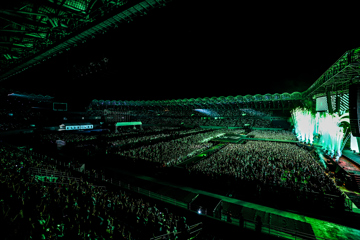Four Aspects Of Pro Wrestling That Are Very, Very Real
It's not all bogus...
In two weeks exactly, the world of sports entertainment will celebrate WrestleMania XXX, which – for those of you with a sense of dignity and, thus, who do not know – is basically like the Superbowl of oiled-up, scantily clad Adonises grunting and playing grab-ass with each other. Titles will change hands, pyrotechnics will explode, and World Wrestling Entertainment chief executive Vince McMahon will add another six inches of depth to his Scrooge McDuck money-swimming tank.
“I keep a glass of Bret Hart's tears by my bedside for extra strength.”
But all the hullabaloo over an event such as WrestleMania is ridiculous, right? After all, pro wrestling is so fake and deliberately manufactured that it makes reality TV seem like documentary, yeah?
Don't miss a beat with our FREE daily newsletter

Picture: Channel Nine
Here we see homo horribilis in its natural habitat, clawing for attention. Again.
Well, aye – to an extent. But, even though I stopped regularly watching pro wrestling about eight years ago, I still bristle any time someone tries to lecture me about how bogus the whole thing is, especially around 'Mania time, because there are plenty of perfectly genuine aspects to the spectacle, such as…
4. The blood
One of the first condemnations I tend to hear from know-it-alls about the Great Unforgivable Sham that is sports entertainment is, “Come on, even the blood looks phony!” OK, sure, maybe it's more pleasant to imagine wrestlers having compartments in their trunks for fake blood capsules that they slyly crack open on their noggins at opportune moments before turning around to show the crowd their newly crimson faces. And, to be fair, it's not that far off the truth – but just replace “blood capsules” with goddamn razor blades.

Picture: thesmartmarks.com
Pictured: Not blood capsules.
If you've ever looked closely at a veteran wrestler's forehead, you'll note that it looks like a topographic map of the worst-designed street system in history, a leathery network of scar tissue upon more scar tissue, because they've spent the better part of the last every night ever pulling tiny razors out of their boots and jamming them into their skulls – aka “blading” – since a) wrestling fans are bloodthirsty maniacs, and b) God knows few cuts piss out blood at incontinent-vampire levels like good, old-fashioned surface head wounds.

Picture: clatl.com
“Booooo, not bloody enough!”
3. The falls
Once their clams about the validity of the copious bodily fluids left on the mat have been settled, often, the next point of contention raised is just how much those falls, or “bumps”, the wrestlers are taking actually hurt. Look at the mat, for crying out loud – it's just one big roped-in trampoline!

Picture: essentialkids.com.au
Juvenile backyard wrestling leagues have never been easier.
Not so fast, there, Hyperbole Harriet. There's unquestionably a bit of bounce in wrestling rings – less than there used to be, in fact – but I shouldn't need to remind you these are >100-kilogram men just casually tossing each other in the general direction of the ground, and anyone with even a basic grasp of human anatomy and the effects of gravity has to understand that you just don't take those kinds of bumps and not have it impact you in some way.

Picture: wwe.com
Pfft. Child's play.
And that's just considering “normal” bumps. It doesn't even take into account when things go wrong, such as the botched powerbomb that left rising wrestler Droz a quadriplegic, or the time at King of the Ring 1998 when professional madman Mick Foley let tattooed behemoth The Undertaker hurl him off a five-metre-high cage and through the Spanish announce table, which knocked him unconscious. Eventually, Foley had to be stretchered out of the stadium, only to have that concussion he just birthed really kick in and drive him to shake off his would-be helpers, stumble back to the ring, re-scale the cage, and endure another ten minutes of being beaten senseless by a giant before getting chokeslammed through the cage roof, knocked out again, beaten some more, and eventually piledriven into thousands of honest-to-god, legitimate thumb tacks.

Picture: wwe.com
There is a reason the phrase “Foley Is God” is a thing.
You should really go watch that match. It is iconic.
2. The injuries
At the end of 1998, the same year he became a part of one of wrestling's most infamous bouts, Mick Foley's career injury list looked like this: six concussions, one broken jaw, two broken noses, one broken cheekbone, four front teeth knocked out, two-thirds of an ear torn off in a ring mishap, one separated shoulder, one fractured shoulder, one dislocated shoulder, second-degree burns from C4 used in a Japanese hardcore match, wounds requiring more than 300 stitches all up, one broken wrist, bone chips in his elbow, six broken ribs, a torn abdominal, a torn ACL, one broken toe, and just a fuck-off number of thumb-tack holes. In the 1999 documentary Beyond the Mat, wrestling fan and filmmaker Barry W. Blaustein laments: “Foley is 33 years old and can't get on his knees to play with his children.”

Picture: allgeektomeblog.wordpress.com
“Not even if he cleaned himself up first.”
The worst part is that Mick Foley isn't even close to the exception. It would be impossible to count the number of careers that have been brought to a screaming halt because the mounting injury toll becomes simply too insurmountable for the wrestler to continue performing. Everyone from top to bottom is a walking shell: Arguably the most powerful performer in the company (on account of having married the boss's daughter), Triple H, tears up muscles like they were editorials in The Australian, while indie wrestler Tommy Dreamer once took a kendo stick to the balls so hard he had to have his testicles drained.

Picture: wwe.com
“I can no longer pee standing up, but people cheered for me once.”
This – again – barely scrapes the surface, since it includes only in-ring injuries, to say nothing of the lasting impact these careers in brutality leave on their alumni. Severe, permanent brain damage is a regular affliction among former grapplers, and has even been suggested as one of the primary causes of former wrestler Chris Benoit's double murder-suicide in 2007. So let's not trivialise the injury side of things any more, 'k?
1. The politics
At the end of the day, the WWE is a business, a particularly violent one in which employees burn brightly and quickly before facing the challenge that every other worker has to deal with on a daily basis: justifying their continued existence in the workplace despite their obviously questionable value.

Picture: wwe.com
This man is the master of appearing useful.
And, boy, does pro wrestling excel when it comes to people doing everything they can in the hopes of making examples of one another just to get ahead. Whether it was a then-fledgling Triple H being the sole wrestler punished for the so-called “Curtain Call” incident at Madison Square Garden in 1996, when four storyline-rival, real-life-best-friend grapplers publicly broke kayfabe (character) and hugged in the centre of the ring, or a now-in-charge Triple H just squashing the hell out of anyone he feels looks at him wrong, there is no question that what goes on behind the scenes is far more dramatic than anything the writers can even dream of managing.

Picture: wwe.com
“God, I just… I really hate your beard. It's so… ugh. Look at it. Just… look at it. Wow. Anyway, enjoy the Hardcore division.”
Perhaps no instance of backstage politics crossing over into the public eye will ever be more widely covered, analysed and debated than the infamous Montreal Screwjob of 1997. A brief history: WWE (then WWF) champion Bret Hart was to jump ship to then-competitor WCW. To avoid a repeat of an incident in which the WWF's women's champion turned up on WCW TV with a WWF belt and literally threw it in the trash, Vince McMahon wanted Hart to drop his belt to fellow main-eventer, and Hart's real-life bitter rival, Shawn Michaels. After some heated back-and-forth, Hart agreed to vacate the belt via a double disqualification, because he would give Michaels the belt over his dead body, especially in front of his home crowd. McMahon agreed, and it all went off without a hitch.
No, wait. This happened:
If you're not into wrestling videos, let me break this down: At a key point in the match, Michaels puts Hart in latter's own signature submission move, the Sharpshooter. The script said that wasn't the end of the match, especially since Hart hadn't submitted, but referee Earl Hebner – under pressure from McMahon – called for the bell on a non-existent tap-out, giving Michaels the win, and then booked it the hell out of there while Hart sat up in angry confusion before going right ahead and openly spitting on Vince. The crowd – sensing something was amiss – screamed bloody murder, and Michaels swore on his kids' lives he wasn't involved (he was). It created a rift between the WWE and Hart that only got resolved nearly 13 years later, and left the company essentially unwelcome in Montreal for close to a decade afterwards. You just can't fake that kind of animosity.

Picture: wwe.com
“Mmm, yep. This one's going in the glass.”
Mitch is a freelance writer who once dreamed of becoming a lucha libre, but lacks any athletic ability whatsoever. He tweets really well, though: @mitchables







